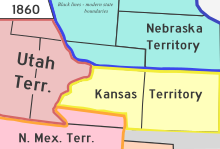
Back Territori de Colorado Catalan Colorado-Territorium German Territorio de Colorado Spanish Coloradon territorio Finnish Territoire du Colorado French טריטוריית קולורדו HE Territorio del Colorado Italian コロラド準州 Japanese 콜로라도 준주 Korean कॉलोराडो प्रांत Marathi
| Territory of Colorado | |||||||||||||||
|---|---|---|---|---|---|---|---|---|---|---|---|---|---|---|---|
| Organized incorporated territory of the United States | |||||||||||||||
| 1861–1876 | |||||||||||||||
 The Territory of Colorado as shown imposed on an 1860 map of the Nebraska, Kansas, New Mexico, and Utah Territories. | |||||||||||||||
| Capital | Denver City 1861-1862 Colorado City 1862 Golden City 1862-1867 Denver[a] 1867-1876 | ||||||||||||||
| • Type | Organized incorporated territory | ||||||||||||||
| History | |||||||||||||||
| February 28 1861 | |||||||||||||||
| August 1 1876 | |||||||||||||||
| |||||||||||||||
The Territory of Colorado was an organized incorporated territory of the United States that existed from February 28, 1861,[2] until August 1, 1876, when it was admitted to the Union as the State of Colorado.[3]
The territory was organized in the wake of the Pike's Peak Gold Rush of 1858–1862, which brought the first large concentration of white settlement to the region. The organic act creating the slave-free Territory of Colorado[2] was passed by Congress and signed by President James Buchanan on February 28, 1861, immediately following the secession of seven slave states that precipitated the American Civil War. The boundaries of the Colorado Territory were essentially identical with those of the current State of Colorado. The organization of the territory helped solidify Union control over the mineral-rich area of the Rocky Mountains. Statehood was regarded as fairly imminent, but territorial ambitions for statehood were thwarted at the end of 1865 by a veto by President Andrew Johnson. Statehood for the territory was a recurring issue during the Ulysses Grant administration, with Grant advocating statehood against a less willing Congress during Reconstruction. The Colorado Territory ceased to exist when the State of Colorado was admitted to the Union in 1876.[3]
East of the Continental Divide, the new territory included the western portion of the Kansas Territory, as well as some of the southwestern Nebraska Territory, and a small parcel of the northeastern New Mexico Territory. On the western side of the divide, the territory included much of the eastern Utah Territory, all of which was strongly controlled by the Ute and Shoshoni. The Eastern Plains were held much more loosely by the intermixed Cheyenne and Arapaho, as well as by the Pawnee, Comanche and Kiowa. In 1861, ten days before the establishment of the territory, the Arapaho and Cheyenne agreed with the U.S. to give up most their areas of the plains to white settlement but were allowed to live in their larger traditional areas, so long as they could tolerate homesteaders near their camps. By the end of the American Civil War in 1865, the Native American presence had been largely eliminated from the High Plains.
- ^ Bauer, William H.; Ozment, James L.; Willard, John H. (1990). Colorado Post Offices 1859-1989. Golden, Colorado: Colorado Railroad Historical Foundation. ISBN 0-918654-42-4.
- ^ a b c Thirty-sixth United States Congress (February 28, 1861). "An Act To provide a temporary Government for the Territory of Colorado" (PDF). Library of Congress. Retrieved May 13, 2023.
- ^ a b c Ulysses S. Grant (August 1, 1876). "Proclamation 230—Admission of Colorado into the Union". The American Presidency Project. Retrieved May 13, 2023.
Cite error: There are <ref group=lower-alpha> tags or {{efn}} templates on this page, but the references will not show without a {{reflist|group=lower-alpha}} template or {{notelist}} template (see the help page).
© MMXXIII Rich X Search. We shall prevail. All rights reserved. Rich X Search
